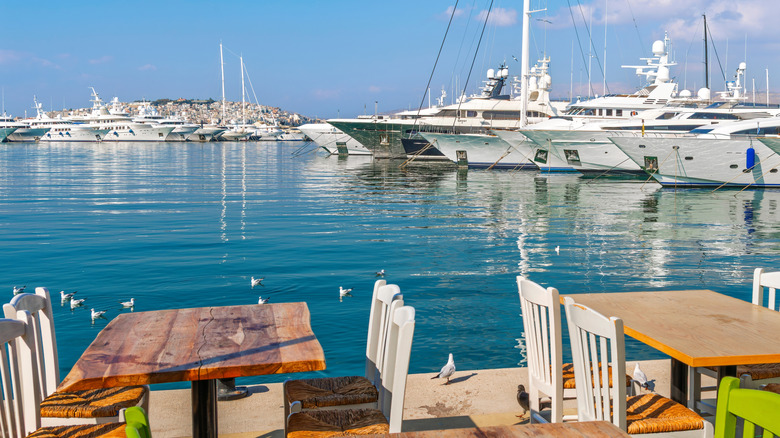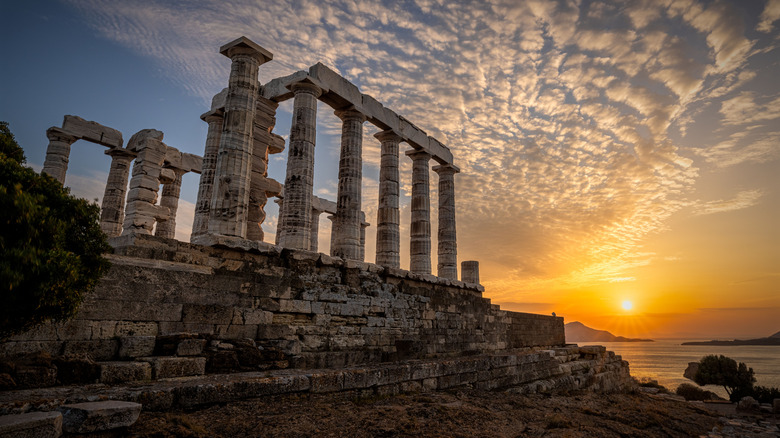Greece's Capital Has A Once-Glamourous Mainland Riviera Full Of Beaches And Resorts That's Making A Big Comeback
It's easy to see why so many travelers make the effort to venture out to Greece's most-visited islands. There's Crete, which draws over five million by being a quintessential getaway packed with food, sunshine, and beaches. There's Santorini, seen by over two million people each year, where the maze-like village of Oia touts renowned views across a sunken volcano in the sea. The thing is, you don't actually need to leave the capital to feel the salt wash of the Aegean, because the Athenian Riviera is currently in the throes of a comeback and it's downright lovely.
Once upon a time, this 40-mile stretch of palm-threaded sands, forested hills, cocktail-clinking beach bars, and shoreline tavernas south of the big city was ground zero for A-listers. It was the 1960s and you'd rub shoulders with the likes of Sinatra and Jackie O on the sands. But the glitz and glamour was fleeting. By the later decades of the 20th century, the riviera had taken second seat to Mykonos and other islands. Its star faded, and visitors to the capital shifted their focus back to the great monuments and the swanky neighborhoods of downtown Athens.
The 2020s have other ideas, though. There's currently a huge regeneration and rejuvenation going on all along this grand old dame of a coast. New hotels, cutting-edge kitchens led by celeb chefs, bustling entertainment complexes — they're all popping up thanks to big investments that can only be counted in the billions. It's a tempting prospect for travelers who want real Greek R&R but don't want to stray too far from the hubbub and cosmopolitan energy of Athens.
Explore the buzzing beaches and resorts of the Athenian Riviera
It's never been easier to feel the pulse of the Athenian Riviera. Nowadays, it's possible to hop trams all the way from Syntagma Square, the beating heart of the city, to the self-proclaimed hub of the riviera in Glyfada — a sand-fringed suburb that has glamour oozing from its yacht marinas and artisan coffee bars. Getting there from the airport is also a cinch: You're looking at a mere 30-minute taxi from arrival hall to a Glyfada shopping strip.
The tram will take you through a tiara of beachside areas. First, there's Flisvos Marina, a major yachting center and a great place for sunset strolls along the quaysides. Then, long Kalamaki Beach, where shingle sands slope into the Saronic Gulf and umbrellas offer spots of rare shade. There's also Ellinikon, an ambitious urban regeneration project featuring Zen gardens, water features, playgrounds, and parklands.
Next up as you head south — by bus, car, or taxi is best after Glyfada — is the elegant town of Vouliagmeni. It's long been seen as one of the area's top swimming destinations because it has a lake and a hodgepodge of beaches. It's now on the forefront of the riviera's new revival thanks to the opening of the 303-room Four Seasons Astir Palace Hotel Athens, a grand redux of the original celebrity hangout from the 60s. Spoiler alert: It's set on its own forest-clad peninsula and offers Michelin-rated dining.
The riviera's wilder side
Vouliagmeni is a mere 14 miles from the center of Athens, but the actual finishing point of the Athenian Riviera on the rocks of Cape Sounion is more than 66 miles out. The upshot? Stick to the big-name resort towns and you'll have only seen a fraction of what this rebounding region has to offer. The rugged, wilder side of the peninsula starts in earnest around Althea Beach, where cliff-backed coves with glassy waters often feel more island than mainland.
Anavissos is another 20-minute drive further south again. The crowd factor reduces here, and you'll find rows of sunbeds right beside the Aegean throughout the summer months. KAPE beach caps things off with a secluded cove that you can only reach by navigating steep stairs that go straight down the cliffs. It's quiet, undeveloped, and very different to the northern side of the riviera.
The last marker of Athens's glitzy strip of coast is the half-ruined Temple of Poseidon, which clings to the end of the cape just as it has done for 2,500 years. Evening tours often go there so you can witness the red-pink light across the marble columns and the Aegean Sea as the sun drops below the horizon.


